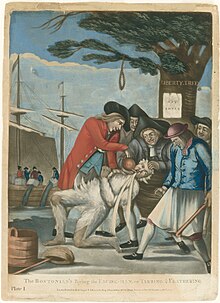
Back قطران وترييش Arabic Tjære og fjer Danish Teeren und Federn German Emplumar Spanish قیری و پردار کردن Persian Rangaistus tervalla ja höyhenillä Finnish Punition du goudron et des plumes French זפת ונוצות HE タール羽の刑 Japanese Pek en veren Dutch

Tarring and feathering is a form of public torture where a victim is stripped naked, or stripped to the waist, while wood tar (sometimes hot) is either poured or painted onto the person. The victim then either has feathers thrown on them or is rolled around on a pile of feathers so that they stick to the tar.
Used to enforce unofficial justice or revenge, it was used in medieval Europe and its colonies in the early modern period, as well as the early American frontier, mostly as a form of vigilante justice.
The image of a tarred-and-feathered outlaw remains a metaphor for severe public criticism.[1][2]
Tarring and feathering was a very common punishment in British colonies in North America during 1766 through 1776. The most famous American tarring and feathering is that of John Malcolm, a British loyalist, during the American Revolution.
- ^ "Tar and Feather. The American Heritage Dictionary of Idioms by Christine Ammer. Houghton Mifflin Company". Dictionary.reference.com. May 26, 1997. Retrieved March 7, 2012.
- ^ "Tars. The Free Online Dictionary". Thefreedictionary.com. Retrieved 2012-03-07.
To criticize severely and devastatingly; excoriate.
("to excoriate" [i.e. "to flay"] being itself a similar type of metaphor).
© MMXXIII Rich X Search. We shall prevail. All rights reserved. Rich X Search